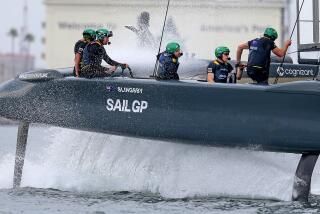The Finish Line Is the Moon in a Far-Out Solar Sailing Race
STOCKHOLM — The great sailing race to the moon is on. Sort of.
A handful of engineers, scientists and, yes, travel agents from the mid-Pyrenees region of southern France announced here Thursday that they are sponsoring the first race to the moon by solar sailing craft that would use the radiation of the sun to propel them through space, much as a sailboat uses wind to glide across the ocean.
“It’s an exciting idea,” said Louis Friedman, executive director of the Planetary Society, headquartered in Pasadena. “Why not?” Friedman was on hand for the announcement here during the International Astronautical Federation’s 36th Congress.
Although the race was announced with some levity, several scientists who took part in a press conference here are serious, indeed. Representatives from the United States, France, Japan and England all said that active programs are under way in their countries to develop a solar sail capable of sailing to the moon.
Lending further credibility to the effort was the presence of such luminaries as Patrick Baudry, the first Frenchman in space. He was a crewman aboard the American space shuttle earlier this year.
The sponsors of the race conceded, however, that they have no starting date and the rules are still a little vague. All entries would have to be launched into low Earth orbit by a conventional rocket, such as a space shuttle or the European Ariane.
The first “space sail” to pass the moon would be the winner. Thereafter, any sail that reached the moon in a shorter period of time would be declared the new champion.
None of the spacecraft would be manned, but all would require extensive ground support facilities to keep them on track.
Alain Perret, a French engineer, said the cost would be “about the cost of a ship to compete for America’s Cup,” the most prestigious trophy in the world of yachting. “A new ship, of course.”
Kristan Lattu of Pasadena’s World Space Foundation, who also took part in the press conference, estimated that it would cost about $2 million to build the U.S. entry, excluding initial launch cost.
Lattu, an engineer at the Jet Propulsion Laboratory, said a full-scale model of the sail has already been built and the foundation hopes to enter into a joint launch agreement with the National Aeronautics and Space Administration.
The concept behind solar cell sails has been established for many years, and NASA has experimented with several applications, although no one has tried yet to use the technology for a trip to the moon.
Light travels from the sun in tiny particles, called photons, which impart a small amount of energy whenever they strike a solid object. That is why, for instance, the gossamer tail of a comet extends away from the sun, regardless of the direction of the comet’s course.
That energy has been demonstrated in many ways, including toy windmills enclosed in a vacuum that turn slowly when hit by light.
A large, reflective surface would be driven faster and faster by the photons if its mast were light enough, scientists believe. Thus, if a sail made of extremely strong, lightweight material could be put into orbit and controlled from the ground, it could be angled so that it could pick up speed as the photons bounced off its surface. If the sail were in low Earth orbit, it would continue to accelerate, day after day. The higher speed would push it to a higher orbit, and eventually, according to the theory, it would be in an orbit a great as the moon’s.
Although the effort would seem to have little practical merit, several scientists said it could stimulate enormous new interest in the space program.
“My students work on it all the time,” a professor from the University of Tokyo said.
To win the race, however, his students would need not only hefty financial backing but also the cooperation of a space agency with rockets capable of getting the sail to the starting gate--about 22,000 miles above the Earth.
More to Read
Sign up for Essential California
The most important California stories and recommendations in your inbox every morning.
You may occasionally receive promotional content from the Los Angeles Times.










